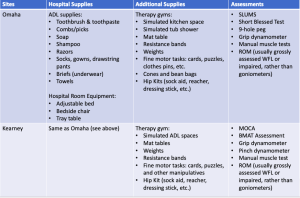7 Introduction to Acute Care Intervention Planning
Intervention planning is an essential part of the role of an acute care occupational therapist. When planning skilled interventions, the therapist must consider the patient’s functional status, goals, and discharge location. Referring to a patient’s goals is one of the best ways to plan an intervention session. This way, you know the session is focused on progressing the client toward their goals for therapy. In some instances, a change in status or increased pain and fatigue may derail your plan. Don’t panic. Acute care intervention plans should be flexible to best meet the client’s needs.
Client-Centered Interventions
When planning interventions, make sure the session is client-centered and focused on their individual needs. For example, if a patient’s plan is to discharge to an assistive living facility that prepares their meals, kitchen mobility and meal preparation tasks may not be appropriate. Additionally, if a patient’s goal is to complete seated grooming and hygiene tasks with moderate assistance to facilitate increased sitting tolerance, a plan to stand at the sink for these tasks may be too advanced.
Consider This:
You planned a session around lower body dressing, but the patient has a change in status and isn’t consistently responding to commands or external stimuli. Think about whether you should consider deferring out-of-bed mobility to ensure patient safety. Conversely, think about if the patient is exceeding their goals during a session and completes lower body dressing independently. Think about how you could scale up the task by having the patient gather the lower body dressing supplies or adding a fine motor component with buttoning, zipping, or tying shoes.
Intervention Supplies
Below is a table detailing the supplies available at both ACTS sites. Review the list below to consider how you could build an intervention session using the materials below. Most therapists try to spend at least 24 minutes with each patient, so consider how you could combine occupation-based tasks and therapeutic activities to build a skilled OT session.

